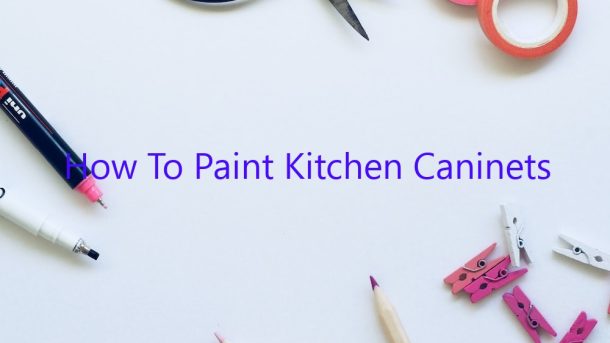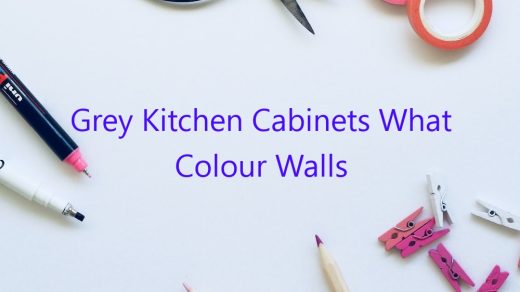A fresh coat of paint can do wonders for a tired-looking kitchen. If your cabinets are in good condition, painting them yourself can be a cost-effective way to give your kitchen a new look.
The first step is to remove all of the cabinet hardware, including the knobs and pulls. If they’re in good condition, you can save them for reuse, but if they’re rusty or damaged, you’ll need to replace them.
Next, use a degreaser to clean the cabinets thoroughly. This will remove any built-up grease or dirt, and will help the paint adhere to the surface.
Once the cabinets are clean, it’s time to start painting. Be sure to use a primer first, as this will help the paint to adhere to the surface and will help to prevent the paint from peeling.
Once the primer is dry, it’s time to start painting the cabinets. Use a brush for the areas around the knobs and pulls, and a roller for the larger surfaces. Be sure to paint in even strokes, and to avoid painting over the same area more than once.
It’s best to paint the cabinets in several thin coats rather than one thick coat. This will help to prevent the paint from peeling.
Once the paint is dry, reinstall the cabinet hardware and enjoy your new kitchen!
Contents
- 1 Can I just paint over my kitchen cabinets?
- 2 What kind of paint do you use on kitchen cabinets?
- 3 Is it better to roll on or brush on paint kitchen cabinets?
- 4 Do you have to sand kitchen cabinets before painting?
- 5 Can you paint directly over painted cabinets?
- 6 How can I paint my kitchen cabinets without brush marks?
- 7 Do you paint both sides of kitchen cabinet doors?
Can I just paint over my kitchen cabinets?
If you’re not happy with your kitchen cabinets, you may be considering painting them. But can you just paint over your cabinets without any prep work?
In most cases, the answer is no. You’ll need to do some prep work before you can paint your cabinets. This includes cleaning them and sanding them down.
If your cabinets are in good condition, you may be able to skip the cleaning step. But you’ll still need to sand them down. This will help the paint adhere to the surface of the cabinets.
If you’re not sure whether you should paint your cabinets or replace them, you may want to consider hiring a professional to help you make a decision. They can inspect your cabinets and give you their professional opinion on whether they can be painted or not.
What kind of paint do you use on kitchen cabinets?
When it comes to painting your kitchen cabinets, there are a few different options you can choose from. The most popular option is to use a latex paint. Latex paint is durable, easy to clean, and comes in a variety of colors. If you are looking for a more durable paint option, you can also use an oil-based paint. However, oil-based paint is not as easy to clean and can be more toxic than latex paint. Another option is to use a cabinet refinishing kit. Cabinet refinishing kits come in a variety of colors and finishes, and are a great option if you are looking to change the look of your kitchen without painting your cabinets.
Is it better to roll on or brush on paint kitchen cabinets?
When it comes time to paint your kitchen cabinets, you have a couple of options: you can either brush on the paint or roll it on. Both methods have their own benefits and drawbacks, so which one is right for you?
If you’re looking for a smooth, even finish, then rolling on the paint is the way to go. It’s also the better option if you’re working with a limited amount of time, as it goes on much faster than brushing. However, if you have a lot of cabinets to paint, rolling on the paint can be quite time-consuming.
Brushing on the paint is a good option if you’re looking for a more textured finish. It’s also a better choice if you’re working with a limited amount of paint, as you won’t have to worry about running out. However, it can be a bit more time-consuming than rolling, and it’s not as easy to achieve a smooth finish.
Do you have to sand kitchen cabinets before painting?
When it comes to painting kitchen cabinets, some people may wonder if they need to sand the cabinets before painting. The answer to this question is, it depends.
If the cabinets are in good condition, you may not need to sand them before painting. However, if the cabinets are old and peeling, sanding them before painting is definitely recommended.
Sanding the cabinets will help the paint to adhere better and will also help to achieve a smoother finish. Additionally, sanding the cabinets will help to remove any old paint or residue that may be on the surface.
If you choose to sand the cabinets before painting, be sure to use a fine-grit sandpaper. Sand in a circular motion, and be sure to sand in all directions. When you are finished sanding, wipe the surface of the cabinets with a clean cloth to remove any dust or debris.
If you are not planning to sand the cabinets before painting, be sure to use a primer before applying the paint. This will help to create a smooth surface and will help the paint to adhere better.
Overall, whether or not you sand the cabinets before painting is up to you. If the cabinets are in good condition, you may not need to sand them. However, if they are old and peeling, sanding is definitely recommended.
Can you paint directly over painted cabinets?
If you’re looking to give your cabinets a quick and easy update, painting them may be the way to go. But can you paint directly over painted cabinets, or do you have to remove the old paint first?
The answer to this question depends on the paint that was used to paint the cabinets in the first place. If the cabinets were painted with a latex paint, then you can probably paint over them with a latex paint without any problems. However, if the cabinets were painted with an oil-based paint, you’ll need to remove the old paint before painting them with a latex paint.
If you’re not sure what type of paint was used to paint your cabinets, you can test it by painting a small section of the cabinet with a latex paint and a oil-based paint. If the latex paint doesn’t peel or chip off, then you can probably paint over the entire cabinet with a latex paint.
If you decide to paint your cabinets, be sure to follow the specific instructions that come with the paint. Also, be sure to use a primer before painting the cabinets, especially if they are a dark color.
How can I paint my kitchen cabinets without brush marks?
If you’re looking to paint your kitchen cabinets without brush marks, there are a few things you can do to help make the process easier. Below are some tips to help you achieve a smooth finish.
1. Start by sanding your cabinets thoroughly. This will help to create a smooth surface for the paint to adhere to.
2. Next, use a primer. This will help to create an even surface and will also help the paint to adhere better.
3. Finally, use a high-quality paint. This will help to create a smooth finish and will minimize the chances of brush marks.
If you follow these tips, you should be able to paint your kitchen cabinets without any brush marks.
Do you paint both sides of kitchen cabinet doors?
When you’re painting kitchen cabinets, do you paint both sides of the cabinet doors? You might be wondering why you would need to do this – after all, the front of the cabinet is the only side that’s visible. But there are a few reasons why you might want to paint both sides of your cabinet doors.
The first reason is that it can make your cabinets look neater. If you only paint the front of the cabinet doors, it can be difficult to get an even coat of paint, and you might end up with streaks or patches. Painting both sides of the doors helps to ensure that the paint is evenly spread, which will give your cabinets a neater appearance.
Another reason to paint both sides of your cabinet doors is that it can help to protect them from wear and tear. The front of the cabinet is likely to be the part that gets the most wear and tear, so painting it will help to keep it in good condition. The back of the cabinet is likely to be less visible, so it’s less important to paint it, but it’s still a good idea to do so in order to protect the cabinet from damage.
If you’re painting your kitchen cabinets, it’s a good idea to paint both sides of the cabinet doors. This will help to ensure that the paint is evenly spread and will help to protect the cabinet from wear and tear.



